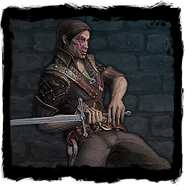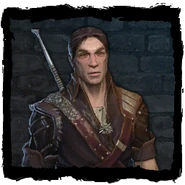- Main
- Netflix series
| And the lord barons and village elders have their heads full of the war and don't have the time to defend their subjects. They have to hire us. It's true. But from what Triss has been telling us all these evenings, it seems the conflict with Nilfgaard is more serious than that, not just some local little war. | |||
| - pg. 57, Blood of Elves (U.K. edition) | |||
Eskel, born as Esau Kelly Kaminski,[1] was a witcher of the School of the Wolf, trained by Master Vesemir at Kaer Morhen, and active during the 13th century. As the sorceress Triss Merigold noted, Eskel emitted a strong magic aura. Though not as famous as his peer Geralt of Rivia, Eskel earned a solid reputation as a professional, reliable witcher, known for his kind and easygoing nature.[2]
Eskel and Geralt, the White Wolf, were like brothers. They grew up together, shared in the Trials, and enjoyed countless moments of camaraderie. A close friend to the younger Lambert and Coën of Poviss, Eskel viewed Vesemir not only as a mentor but also as a father figure. Every winter, he returned to Kaer Morhen to exchange stories and rejuvenate before heading back out on The Path.[2]
Quick Answers

Who trained Eskel in the School of the Wolf?

What kind of aura does Eskel emanate according to Triss Merigold?

How is Eskel's relationship with Geralt of Rivia described?

What is Eskel's reputation as a witcher?

Who plays the character of Eskel in the Witcher Netflix series?

Biography
Early life
Born in the mountains, Eskel hailed from a family of hill-folk. His mother used to sing him an old hiking tune about a hen, which would later become the only memory he retained of her.[3]
Under unknown circumstances, the Witchers' Settlement in the Blue Mountains eventually became Eskel's home. It was there that he befriended Geralt, a peer who would become almost like a brother to him. Together, they indulged in youthful mischief. On one occasion, Eskel and Geralt captured a large forest bumblebee and tied it to a jug, watching its frantic movements with fits of laughter until Vesemir caught them and punished them with a leather strap.[4]
Tirelessly studying all manner of creatures, the young trainees often heard their teachers repeat crude jokes about virgins, unicorns, and basilisks and mirrors—jokes that quickly lost their charm. The trainees found the most primitive of these tales to be variations on how a young witcher might shake hands with a female dragon.[5]
To become full-fledged witchers, the youth underwent the excruciating and dangerous Trial of the Grasses, which altered their physiology, granting them abilities such as cat-like vision in the dark. Eskel feared for Geralt's life when his friend's hair turned white as a side effect of the trial. Despite this, both managed to survive the ordeal together. They trained on The Trail, a dangerous course filled with obstacles that was infamously known as "The Killer."[2]
The Child Surprise
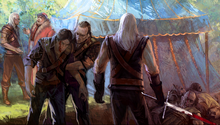
No earlier than 1229,[N 1] Eskel saved a prince of Caingorn during a fierce struggle with a werebbubb gang. As a reward, the prince offered Eskel anything he desired. However, unable to think of a specific request, Eskel recited the fabled Law of Surprise that he had heard from Vesemir over the years: "Give me that which you find at home yet do not expect."
This is how Princess Deidre Ademeyn, born during an eclipse, became Eskel's surprise child. Eskel, reluctant to accept responsibility, went to great lengths to avoid returning to Caingorn. He took long, convoluted routes to distance himself from the kingdom, hearing tales of Deidre maturing into a highly unpredictable young woman. She had also discovered an innate gift for blocking magic, which many superstitiously interpreted as the accursed mutation of the Black Sun. To understand what this all meant, Eskel carried a collective work about the phenomenon. He suspected that the Council of Wizards had meddled too much in state affairs, causing the situation to spiral out of control. Had they not sent Sabrina Glevissig, Deidre might not have been ostracized.
Around late 1240s or early 1250s,[N 2] Deidre sought asylum at Kaer Morhen. Vesemir took her in, while Eskel worked on a kikimore hatchery in an old mine outside the keep, all while trying to devise a solution to the growing crisis. Geralt found Eskel there, and the two discussed the situation. Eskel cared for Deidre but was unwilling to send her to Glevissig, who, driven by unproven conclusions, sought to kill and study the princess.
After returning to Kaer Morhen, Vesemir called his pupils together to present ideas. Unsure of the best course of action, Eskel turned to Geralt for guidance.
If the witchers chose to help her: The witchers decided that they should aid Eskel's surprise child. Unfortunately, Eskel became involved in a scuffle between Deidre and her younger brother, Merwin Ademeyn, a misguided ally of Glevissig who sought to rule. During the confrontation, the princess accidentally slashed Eskel across the face. Deeply regretful, she left, resolving the situation. Several years later, she sent Eskel a letter sealed with her royal seal. Eskel, however, burned the letter without reading it and never spoke of her again.
If the witchers chose not to help Deidre: The witchers decided not to help Deidre, which led to a furious outburst from her. In her rage, Deidre nearly killed Eskel before fleeing. Sabrina intervened, healing Eskel's wounds, though she could not remove the deep scars from his face. She insisted that the witchers leave Deidre to her, promising to find and deal with her herself. It is unclear whether the witchers allowed this, but for the next two years, Deidre became a notorious outlaw, terrorizing southern Kaedwen. Eventually, she was hunted down and killed, either by Sabrina and her allies, who tortured and examined her for mutations (finding none), or by a mysterious scarred man who refused to collect the bounty on her head.
Although the witchers of Kaer Morhen never spoke of Deidre again, none of them ever forgot her. Each of them carried her memory in their heart. The bard Dandelion would later compose a ballad about the events.[6]
Training Ciri
In early autumn of 1264, Eskel returned to Kaer Morhen for the winter. One day, while he was closing the main gate to preserve the warmth inside, Geralt arrived with Ciri. Eskel embraced Geralt, though he was initially skeptical of the idea of training Ciri. Nonetheless, he agreed to her training and welcomed the girl to Kaer Morhen, taking her luggage. When she asked who else was at the keep besides Vesemir, Eskel introduced her to Lambert and Coën, their comrade from the School of the Griffin.[2] [7]
Over the following months, Eskel helped Ciri with her training. However, he grew increasingly concerned about the trances she fell into after accidentally drinking White Gull.[2]
The third trance, in particular, caused great distress among the witchers. They gathered together in silence, each unsure of how to handle the situation. Unable to endure the tense quiet, Eskel swore, stood up, and went to fetch a strong drink. As Coën and Geralt discussed the issue, Eskel poured himself some vodka. Initially, Vesemir had been furious about the alcohol, but after a moment, he beckoned Eskel to pour him a pint as well. The silence continued, until Eskel, seeking a solution, suggested summoning a witch for help.
When Lambert mockingly commented on Ciri's latest prophecy—suggesting that witchers might die by monster teeth, or perhaps by dental gangrene—Eskel added, in a seemingly serious tone, that this could be another possible interpretation. Vesemir immediately hushed both of them, reminding them that such matters should not be taken lightly.[5]
They ultimately decided to summon Triss Merigold, who arrived near Midinváerne in 1265. Upon meeting her, Eskel, aware of his own potent magical aura, bowed and politely kissed her hand. At first, he was suspicious of Triss's intentions, fearing she might reveal the witchers' secrets to the Brotherhood of Sorcerers. However, she quickly convinced him that she had no such plans. Eskel had a generally good rapport with Triss, listening carefully when she shared her thoughts on how the witchers were treating Ciri.
After discussing the situation regarding Ciri's trances and prophecies, Triss informed the witchers about the broader issues affecting the Northern Kingdoms. Eskel, who had been asking several questions at first, fell silent as the conversation shifted into a heated debate about neutrality, which he chose not to engage in further.[2]
On the path
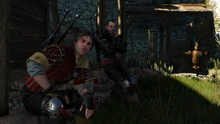
Before 1267, Yennefer of Vengerberg visited Kaer Morhen, and Eskel had the chance to meet her.
Despite never achieving Geralt's level of fame, Eskel was equally skilled and experienced, with a reputation as a reliable and efficient witcher. One of his notable deeds was attempting to save a little girl from a basilisk. He successfully split the creature open, but by the time he reached her, she had already been half-digested. Eskel had been in the area hunting a zeugl at the time. He didn't shy away from more adventurous encounters either—he once slept with a succubus and indulged in fisstech with her.[3]
During the warmer months at Kaer Morhen, Eskel would venture out to drive away dangerous harpies, helping to keep the area safe.[8]
Two attacks on Kaer Morhen
Salamandra burglary

One day before Belleteyn of 1270, Eskel and Lambert were at Kaer Morhen, tasked with repairing a staircase. However, they postponed the task. They were also training the latest witcher student, Leo, an orphan Vesemir had brought to Kaer Morhen. The following day, while Eskel and Vesemir were out hunting, a magical storm swept through the area. They discovered an unconscious Geralt—who had been presumed dead—near the keep and loaded him onto a cart. As they traveled back, Eskel reassured the amnesiac Geralt that everything would be fine, as he was among friends now.
Shortly after Geralt's return, Azar Javed and the mysterious Salamandra attacked. Eskel, along with his comrades, defended the keep. Vesemir assigned Eskel and Lambert to assist him in fighting Savolla's frightener, but the bandits gained the upper hand. The witchers retreated to the upper courtyard, where Merigold chastised Eskel and Lambert for not repairing the staircase, which could have helped with the defense. When she speculated that Salamandra might be after witcher mutagens, Lambert was skeptical, but Eskel supported her theory. Although Eskel helped defeat the frightener, the bandits managed to escape with the mutagens after killing Leo. After the fight, he spent some time in the keep's armory and also practiced fistfighting with Geralt.
After the witchers burned Leo's body on a funeral pyre, they split up to gather information. Eskel headed west, where he had contacts and preferred the coastal climate.[9]
Bounties in 1271
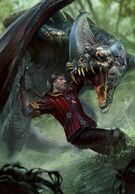
In the year following the defeat of Jacques de Aldersberg, the mastermind behind Salamandra, Eskel undertook several contracts. One of his notable contracts involved dealing with a hypnotic samovila. He was hired to free a peasant farmer from its influence but left when the farmer, who had fallen in love with the samovila, asked Eskel to trap her for him afterward. Eskel refused, recognizing the danger of entangling the farmer further in such a predicament.
Around six months before the witchers' final clash with the Wild Hunt, Eskel was ambushed by a Manticore in the forests of Creyden. The beast moved so quickly that it didn't trigger his medallion. Eskel was injured in the skirmish and received a sizable scar, but he managed to kill the Manticore and take its head to the nearest village elder. However, there was no contract on the creature's head, and the elder swore he had never heard of such a monster before, meaning Eskel didn't receive any payment for his trouble.
On another contract in Aldersberg, Eskel was tasked with hunting a katakan, an ancient vampire that had been killing drunkards. He spent a month stalking the creature before devising a plan to catch it at a masquerade ball held by local nobles. Eskel used the event to his advantage—he had made an agreement with an alchemist: she would load herself with magic mushrooms, vodka, and fisstech and act as bait. During the ball, Eskel enjoyed the company of several ladies before dealing with the vampire. The katakan took the bait and drank his fill of the alchemist's blood. Fighting became an afterthought, allowing Eskel to kill the vampire. He took its body back to Kaer Morhen for further study, as it had been a stronger one than he had encountered before. He believed that a proper examination of its body parts might lead to a new witcher method for determining age based on the vampire's footsteps.[3]
Clash against the Wild Hunt
In the fall of 1272, Eskel was hunting a forktail—a draconid that needed to be removed as Yennefer lacked the organs necessary to distill ingredients for disenchanting Uma. After Geralt tracked him down, Eskel agreed to let the White Wolf join the hunt. The two caught up on recent events in their lives as they tracked the forktail to its lair and ultimately killed it. Afterward, Eskel mounted his horse, and the two engaged in a friendly race back to Kaer Morhen.
Once inside, Eskel showed Geralt the katakan specimen he had recently obtained and began its autopsy. Later, when Yennefer started the transformation process on Uma, Eskel was visibly troubled by Uma undergoing the Trial of the Grasses. He eventually walked off, but returned with some rags to help clean up after Yennefer, who had been vomited on during the process. After Yennefer successfully broke Uma's curse, she went to rest, and Eskel sat down with Lambert to share stories and drink. When Geralt joined them, they all began drinking together.
If Geralt opts to get drunk with the rest: The three of them became increasingly drunk as they swapped tales, played a drinking game, and even dressed up as the Lodge of Sorceresses in a playful attempt to invite them to Kaer Morhen. While fiddling with Yennefer's megascope, they briefly made contact with Hierarch Cyrus Engelkind Hemmelfart of Novigrad, which led to Yennefer storming in to stop the charade. Eskel had to return the clothes they had taken in jest.

In the wake of Ciri's arrival at Kaer Morhen, Eredin Bréacc Glas and the Wild Hunt launched an attack. Eskel defended the inner courtyard of the keep, where Caranthir opened a portal and brought more riders through. Eskel held his own in a duel with Caranthir, managing to fight him expertly until Caranthir used his teleporting abilities. This almost cost Eskel his life, but Ciri intervened and saved him. Caranthir, called away by orders, retreated, though not before commanding his warriors to kill Eskel and Ciri. The two witchers fought back, killing the Hunt's warriors and continuing to defend the keep.
As the battle progressed, the defenders were pushed back to the keep's courtyard, where suddenly a freezing cold tore through the gate, freezing Eskel and the others in place. He remained frozen until Eredin and the Aen Elle warriors vanished, driven off by Ciri's burst of power following Vesemir's death. Eskel's ears had bled from the shock of the magical release, though he was freed once the battle was over.[3]
Departure south
In the aftermath of the battle, Eskel bid a final farewell to his valiant master, Vesemir. Struggling to imagine Kaer Morhen without him, Eskel decided to leave, with his sights set on Lormark. Recently ravaged by war, Eskel believed the region would provide ample work opportunities for a seasoned witcher like himself. Although Eskel would take over the responsibility of watching over the witcher's keep.[3]
Appearance and personality

| Ciri looked up into his face and barely restrained her frightened scream. He wasn't human. Although he stood on two legs, although he smelled of sweat and smoke, although he wore ordinary human clothes, he was not human. No human can have a face like that, she thought. | |||
| - pg. 39, Blood of Elves (U.K. edition) | |||
The Wolf witcher had a menacing, metallic voice that sounded like a dog's barking to Ciri when she first heard it. The most prominent feature of his visage was a long, hideous, semi-circular scar running from the corner of his mouth across the length of his cheek up to the ear. It got itchy when he was nervous or embarrassed. Minus the scar and hair color, Eskel and Geralt resembled one another like true brothers. Eskel's hands emanated powerfully with magic, with more Power than the White Wolf's. This triggered pleasant, piercing vibration in mages.[2]
Eskel was calm, patient, stable, thoughtful and polite. Even when he disagreed wholeheartedly with a topic, he feigned politeness and interest in the matter. What betrayed him in such situations was avoiding eye contact. He enjoyed drinking and laughing with friends. Quite self-aware, he had no delusions about his appearance but that didn't hinder him from smiling. His fitting, mature behavior, especially when it came to Ciri compared to the other witchers endeared him to Triss Merigold.[2] Vesemir prized Eskel's reliability.[10]
The Witcher
Journal entry
- The calm and reasonable witcher is my peer. We are similar in many ways and people often think we are brothers.
Associated quests
The Witcher 3: Wild Hunt
Journal entry
- All witchers have a great deal in common, but with Eskel and Geralt, the similarities are particularly striking. They first met as two boys of the same age swinging wooden swords at Kaer Morhen. They then went though an ordeal together: the first round of selections, the murderous Changes, the Trial of the Grasses, and training on the Gauntlet - the witchers' daunting obstacle course. They also received hidings together for more than one act of childish delinquency. When they became adults, they walked the Path separately, but still reconvened at Kaer Morhen nearly every winter to wait out the cold, drink to their successes and remember fallen comrades.
- Though Eskel never gained Geralt's renown, he equaled the White Wolf in experience and carried out his contracts with care and efficiency. Death had almost taken him many times during his hunts, yet in an ironic twist the hideous scar on his face came not from a monster claw but from the blade of Deidre Ademeyn, his highly unpredictable Unexpected Child.
- Perhaps this traumatic experience lay at the root of Eskel's dislike for Yennefer, though he tried not to let this get in the way of friendship with Geralt.
- Eskel took active part in the defense of Kaer Morhen, standing bravely in the face of overwhelming odds to fight one of the Hunt's generals. When Vesemir died, he took over responsibility for watching over the witchers' keep.
Associated quests
- Kaer Morhen
- The Battle of Kaer Morhen
- No Place Like Home
- To Bait a Forktail...
- Ugly Baby
- Blood on the Battlefield
Trivia
- While in Crossroads of Ravens it's revealed that Eskel coined his name himself by combining first syllables of his real names, in real world name "Eskel" derives from Old Norse "Áskell", formed from áss ("god") and ketill ("cauldron" or "helmet"). This may be linked to Andrzej Sapkowski's penchant for foreign-sounding names.[11]
Gallery
Footnotes
- ↑ Assuming that Eskel graduated Kaer Morhen in the same year as Geralt.
- ↑ As with other dates in the first game, 1232 provided in the Price of Neutrality doesn't align with other sources. By the time of that story, the Wolf School was already inactive, with only a few witchers still alive. This contrasts with the information in Blood of Elves, according to which the last witchers were trained in Kaer Morhen about 25 years before the action of the novel, and Crossroads of Ravens, which had Geralt, Eskel's childhood friend of similar age, leave the Keep for the first time in 1229, which means that Deidre could not be born before that date; any earlier date of the Curse of the Black Sun would also make Syanna way older than she appears in Blood and Wine expansion. Taking all of this into consideration, 1232 as the date of the adventure has to be excluded.
References
- ↑ 1.0 1.1 Crossroads of Ravens
- ↑ 2.0 2.1 2.2 2.3 2.4 2.5 2.6 2.7 Blood of Elves
- ↑ 3.0 3.1 3.2 3.3 3.4 The Witcher 3: Wild Hunt
- ↑ The Last Wish
- ↑ 5.0 5.1 The Lady of the Lake
- ↑ The Price of Neutrality premium module
- ↑ Szpony i kły
- ↑ A Fractured Land: Tales of the Northern Realms
- ↑ The Witcher
- ↑ Gwent: The Witcher Card Game
- ↑ "KUL 1998" – 1998 Interview with Andrzej Sapkowski
External links
 See the GWENT standalone game version card: Eskel
See the GWENT standalone game version card: Eskel






